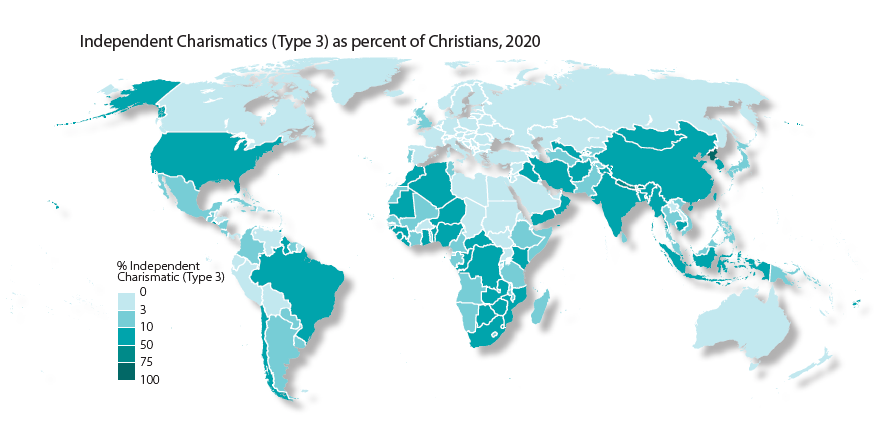Demographics of Independent Charismatics Worldwide
DR. GINA A. ZURLO
CO-DIRECTOR, CENTER FOR THE STUDY OF GLOBAL CHRISTIANITY
Here’s a short excerpt from our new forthcoming book, Introducing Spirit-Empowered Christianity: The Global Pentecostal and Charismatic Movement in the 21st Century (Oral Roberts University Press, 2020). For more on the subject, see the article by Daniel Sillman in Christianity Today, “Have Pentecostals Outgrown Their Name?”.
While the classification and chronology of the first two types of Pentecostals and Charismatics is rather straightforward, there are thousands of churches and movements that “resemble” the first two types but do not fit their definitions. These constitute a third type and often pre-date the first two types. For lack of a better term, these are called “Independent Charismatics.” Part of the rationale for this term is the fact that they are largely found in the Independent category of Christians (separate from Catholics, Orthodox, and Protestants). Thus, Type 3 includes Pentecostal or semi-pentecostal members of the roughly 250-year-old Independent movement of Christians, primarily in the Global South, of churches begun without reference to Western Christianity. These indigenous movements, though not all explicitly Pentecostal, nevertheless have the main features of Pentecostalism. In addition, since the Azusa Street revival, thousands of schismatic or other independent Charismatic churches have come out of Type 1 Pentecostals and Type 2 Charismatic movements. They consist of Christians who, unrelated to or no longer related to the Pentecostal or Charismatic denominations, have become filled with the Spirit, or empowered by the Spirit, and have experienced the Spirit’s ministry (though usually without recognizing a baptism in the Spirit separate from conversion); who exercise gifts of the Spirit (with much less emphasis on tongues, as optional or even absent or unnecessary) and emphasize signs and wonders, supernatural miracles and power encounters; but also do not identify themselves as either Pentecostals (Type 1) or Charismatics (Type 2). In a number of countries, they exhibit Pentecostal and Charismatic phenomena but combine this with a rejection of Pentecostal terminology. These Christians frequently are identified by their leadership as Independent, Postdenominationalist, Restorationist, Radical, Neo-Apostolic, or “Third Wave.”
Thus, the third type is Independent Charismatics (also known as neocharismatics or neopentecostals) who are not in Protestant Pentecostal denominations (Type 1) nor are they individual Charismatics in the traditional churches (Type 2). Type 3 is the most diverse of the three types and ranges from house churches in China to African Initiated Churches to white-led Charismatic networks in the Western world. It includes Pentecostals who had split off from established Protestant denominations (Type 1) and who are then labeled “Independent.” Independent churches formed by Charismatic leaders (Type 2) who founded new congregations and networks are also included. Some Independent Charismatics speak in tongues, but healing and power evangelism are more prominent in this type than in the other two.
While found in many of the same countries as Pentecostals and Charismatics, Independent Charismatics are largest in the United States, China, and Nigeria. Independent Charismatics experience growth by planting new churches and by schisms from traditional denominations. Of the three types, Independent Charismatics are most strongly concentrated in the Global South where new forms of Christianity have grown in the past 120 years. Pentecostal, Charismatic, and Independent Charismatic churches continue to grow in Africa, Asia, and Latin America while slowing in Northern America and Europe. Exceptions to this trend can be found among Independents in the United States (still growing) and Charismatics in Europe (some growth among Roman Catholics). Another significant trend is the migration of Spirit-Empowered Christians from the Global South to the Global North. Thus, some of the largest congregations in Europe are African Independent charismatic in origin. In the United States, many recent Hispanic arrivals, both documented and undocumented, are either Catholic Charismatics or Pentecostals.
